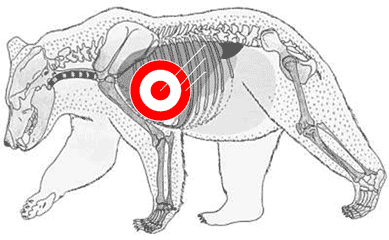Online Bear Baiting Clinic
Shooting
Shot Placement
Probably the biggest advantage of hunting over a bait station is the opportunity for good shot placement at close range, ensuring a clean kill. You’ve invested all this time and effort to properly set up your bait site, so now it’s time to make a quality shot. Once you’ve determined the bear is one you want to harvest, let the bear settle down at the bait site. Regardless of your choice of weapon--bow, rifle, handgun or muzzleloader--the most effective shot will be into the heart/lung area.
Consider the bullet or arrow’s angle of entry. By properly setting up your bait container and cubby of logs in relationship to your tree stand or ground blind, you can force the bear into a proper angle to expose the vital areas. The diagram below shows the proper shot placement to hit the bear’s heart/lung area. However, especially if you are bowhunting, you will get a clearer shot at this vital spot if you wait for the bear to move its nearest foreleg forward. If you are a bowhunter, take practice shots at your site to build your confidence from an elevated position. If you’re using a firearm, get to a shooting range and ensure your gun is shooting accurately before the season opens. Always remember that a bear is a three-dimensional object, not flat like a paper target. If you are shooting down at your target instead of horizontally, your point of aim will need to be below your intended point of impact to compensate for the angle of trajectory and to ensure that you hit the vitals.

After the Shot
Patience is also a virtue after you’ve made your shot. If the bear runs out of sight, it is advisable to wait at least 30 minutes before tracking the bear, even if you have hit the bear in the lungs. If you follow a wounded bear too soon, its adrenaline will likely kick in and it may escape any efforts you make to track it. The further a bear runs from the bait site, the more difficult it will be to find. For this reason, you should get very familiar with your area beforehand; know where the bear trails lead and where the main game trails are located. Also identify any areas of heavy cover such as a swamp or marsh; a wounded bear will likely head for such a feature. Carry fluorescent trail marking tape with you, and affix pieces as you follow the blood trail. Rain can quickly eliminate a blood trail, so having a marked trail may assist in reconstructing the travel of the wounded bear. Some bowhunters use a game tracker to increase their odds of recovering bears. When approaching a downed bear, be very careful. Always approach from behind and above the animal and be ready for a follow-up shot.
